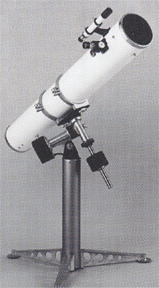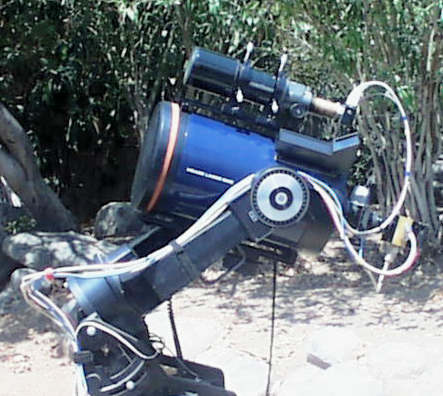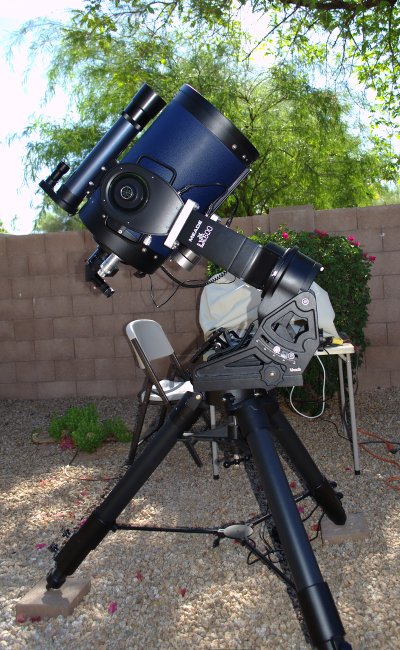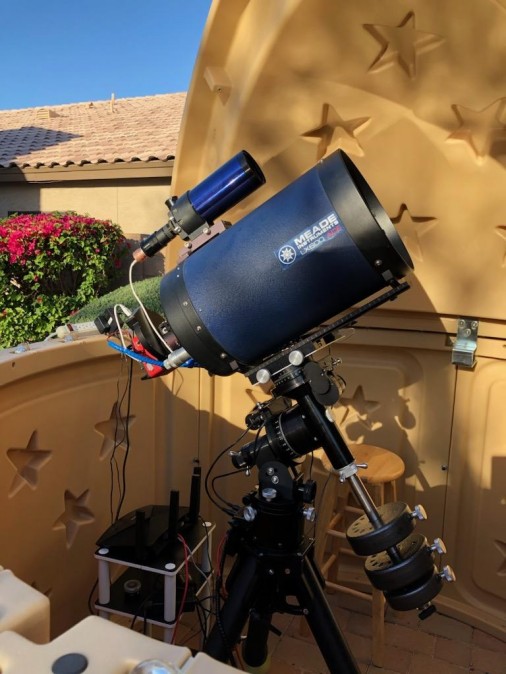Telescopes I've Owned

My first real telescope was a Meade 8" f/6 826 Newtonian on a German mount. That was around 1977 . It was not a very good mount. The clock drive would wind up behind the stiction until it had enough to overpower it and then it would jump, wiggle a while and stick again. You see it had no bearings. It had the wide spot in the RA housing where bearings should go, but it wasn't machined to hold bearings. It just had a teflon washer. It looked like a good mount, but it wasn't a good mount. Optically it was a great tube, but the mount was just bad.
Things have progressed a little since then. Meade discovered bearings, for one thing.
In 1979 I was on a project that involved getting data out of a 100 x 100 pixel EE&G Reticon CCD camera. I envisioned a time when people could run their telescopes from inside the house via these CCD cameras, using them for finding and guiding. With graphical overlays of crosshairs so they could manually guide. Then they would only need to go outside to change the film in the camera. I had no clue.

Next was the LX200 10" f/10, also from Meade. What can I say? It is one of the most popular telescopes ever. Here it is with a water-cooled Genisis-16 camera. My guide camera was a Logitech Quickcam. The original white ball Quickcam. Monochrome, 6-bit converter, and parallel interface. It took two computers to run this rig. It suffered the same fate as many of the "classic" LX200s: The motors would start up and just go until I powered off the scope. Eventually, the DEC axis control fried altogether, and the thing turned into a big rock tumbler.

And finally, the Meade 12" LX600. Beautiful scope - a lot like the LX200 on the surface, but underneath it is more like the LX200 GPS with a guide scope and an f/8 Advanced Coma Free OTA. Works pretty well. The positioning is 100% there. Tracking is 90% there if I use periodic error correction. It has the same focal length as the 10" f/10 LX200, too.
It disintegrated electrically one day. Almost everything quit working - Starlock, GPS, computer interface, PEC, non-volatile memory. But it would still slew and track. I sent it to Meade then $750 and two months later they sent it back with a working guide scope, GPS and other repairs. They even cleaned it. Very good service. Although I would have liked to have had it back sooner, it gave me an opportunity to use a big scope for a while.
I bought the LX600 because it had an integrated guider, and that amazing GOTO accuracy. Two years in I added a Stellarvue F80 80mm f/3.8 finder scope. Wow. I could see stars through it! I've since changed out the right angle focuser on the finder for a straight-through 2" focuser, and added a ZWO ASI290MM-Mini camera and it has replaced the Starlock as the guider. The Starlock was getting unreliable. It couldn't find good stars to guide on.
Going by past numbers, the next scope would be a 14", but I'm betting it's a little refractor of some kind. "One person can set up a 12-inch cat." True, but another will have to operate it while the first person catches their breath. The LX600 as configured weighs in at over 175 lbs: 75 for the scope, 50 for the tripod, and 25 for the wedge. Plus 25 for the guidescope, cameras, focusers, the filterwheel, power box, Raspberry Pi, USB hub, and power supply. And all of those cables.
Update: 2021-06-21 (GT81) I guess I was right. I picked up an 81mm refractor, and I love it. Right now it is piggybacked on the LX600, but I hope to get a separate mount for it in the next year or so. That would allow me to take the scope out to a dark sky site. You can see it at GT81.
Update: 2022-10-17 (POD) My wife bought me a SkyShed POD. It makes all the difference in the world. The scope is really protected, but it doesn't keep the dust from settling on everything. It took 2 days to assemble, and a little help to get installed, but it wasn't hard. I had to assemble it around the LX600, so I could get the position right.
Update: 2023-03-30 (G11G2) So I did get a mount - a Losmandy G11G2 mount. I got that particular model because it would carry the OTA from the LX600, and the little GT81, interchangeably. Here is a picture of the Losmandy carrying the 12" OTA, with an ETX-90 I was trying out as a guider. That experiment was a failure - the ETX is just too floppy inside. I've since gone back to the 80mm f/3.75 Stellarvue guider.

The electronics are setup in such a way that I can trade scopes easily. I unplug the cameras, filter wheel and focuser, pull one OTA off, then put the other one on, and hook up the same cables to that OTA. Each scope has a dedicated focus motor and guide scope, but they share the cameras and the filter wheel. I used a spiral cable wrap on the scope wiring.
Update: 2023-06-07 (ApexED) An ApexED makes the Meade a 12" f/5.2 with a focal length of 1585mm. That is a 0.65 reduction. My camera has a 4/3" sensor, so I don't find significant vignetting, but there is some. I'm currently trying to get the spacing right. I measured everything and used the right spacers and shims, but the sensor was too far from the reducer. I pulled 2.85mm of shims out, and it is looking much better.